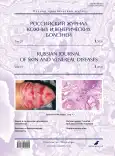Сложный пациент на приеме у косметолога: ранние изменения губ у курящих женщин, причины, способы коррекции
- Авторы: Ширшакова М.А.1, Морозова Е.А.2
-
Учреждения:
- ООО «Центр врачебной практики»
- ФГАОУ ВО «Первый Московский государственный медицинский университет им. И.М. Сеченова» Минздрава России (Сеченовский Университет)
- Выпуск: Том 23, № 1 (2020)
- Страницы: 57-64
- Раздел: КОСМЕТОЛОГИЯ
- URL: https://journals.rcsi.science/1560-9588/article/view/41909
- DOI: https://doi.org/10.17816/dv2020157-64
- ID: 41909
Цитировать
Аннотация
Губы курильщика быстрее подвергаются выраженным изменениям в результате воздействия активных форм кислорода, содержащихся в больших количествах в табачном дыме. Существуют свидетельства важности окислительного стресса в развитии заболеваний, связанных с курением, таких как рак полости рта, рак легкого, хроническое обструктивное заболевание легких. Повреждающее действие происходит в результате нарушения баланса между генерацией активных форм кислорода и их детоксикацией. Маркерами окислительного стресса считают параметры перекисного окисления липидов, активности глутатионовых и антиоксидантных ферментов и окислительные повреждения ДНК. Разрушение гиалуроновой кислоты (ГК) – единственного препарата, применяемого для коррекции формы и контура губ, – у курящих пациентов ускорено за счет участия ГК в реакциях с активными формами кислорода, а не только из-за ферментативного расщепления гиалуронидазой. Маннитол обладает выраженными антиоксидантными свойствами, что делает его идеальным вспомогательным веществом в составе филлеров на основе ГК. Профиль безопасности маннитола давно установлен и хорошо изучен как в пищевой, так и в фармацевтической промышленности. Представлены данные, свидетельствующие о том, что маннитол в качестве поглотителя свободных радикалов при его включении в состав филлеров на основе ГК препятствует разрушению введенной ГК. Приводится обзор препаратов, разработанных на основе этой стратегии. Включение маннитола в состав гиалуроновых филлеров является эффективным и безопасным способом улучшения как краткосрочных, так и долгосрочных эстетических эффектов введения ГК.
Ключевые слова
Полный текст
Открыть статью на сайте журналаОб авторах
М. А. Ширшакова
ООО «Центр врачебной практики»
Автор, ответственный за переписку.
Email: doc.elene@mail.ru
Россия, 127473, г. Москва
Елена Александровна Морозова
ФГАОУ ВО «Первый Московский государственный медицинский университет им. И.М. Сеченова» Минздрава России (Сеченовский Университет)
Email: doc.elene@mail.ru
ORCID iD: 0000-0001-5826-5018
кандидат медицинских наук, ассистент кафедры кожных и венерических болезней В.А. Рахманова Института клинической медицины им. Н.В. Склифосовского
Россия, 119991, г. МоскваСписок литературы
- Губанова Е.И. Губы. Формы и старение. Эстетический атлас. М.: Валлекс М; 2009.
- Pavlou P., Rallis M., Deliconstantinos G., Papaioannou G., Grando S.A. In-vivo data on the influence of tobacco smoke and UV light on murine skin. Toxicol. Ind. Health. 2009; 25(4-5):231-9.
- Benowitz N.L., Jacob P. Metabolism of nicotine to cotinine studied by a dual stable isotope method. Clin. Pharmacol. Ther. 1994; 56(5):483-93.
- Harman D. Aging: a theory based on free radical and radiation chemistry. J. Gerontol. 1956; 11(3):298-300.
- Harman D. Free radical theory of aging. Mutat. Res. 1992; 275(3-6):257-66.
- Yin L., Morita A., Tsuji T. Alterations of extracellular matrix induced by tobacco smoke extract. Arch. Dermatol. Res. 2000; 292(4):188-94.
- Wallstrom M., Sand L., Nilsson F., Hirsch J.M. The long-term effect of nicotine on the oral mucosa. Addiction. 1999; 94(3):417-23.
- Gottipati K.R., Poulsen H., Starcher B. Passive cigarette smoke exposure inhibits ultraviolet light B-induced skin tumors in SKH-1 hairless mice by blocking the nuclear factor kappa B signalling pathway. Exp. Dermatol. 2008; 17(9):780-7.
- Rowe R.C., Sheskey P.J., Cook W.G., Fenton M.E., eds. Handbook of Pharmaceutical Excipients. 7th ed. Washington DC: Pharmaceutical Press; 2012:479-82.
- Paterson I., Klausner J.M., Goldman G., Pugatch R., Feingold H., Allen P., et al. Pulmonary edema after aneurysm surgery is modified by mannitol. Ann. Surg. 1989; 210(6):796-801.
- Nicholson M.I., Baker D.M., Hopkinson B.R., Wenham P.W. Randomized controlled trial of the effect of mannitol on renal reperfusion injury during aortic aneurysm surgery. Br. J. Surg. 1996; 83(9):1230-3.
- Shah D.M., Bock D.E., Darling R.C., Chang B.B., Kupinski A.M., Leather R.P. Beneficial effects of hypertonic mannitol in acute ischemia-reperfusion injuries in human. Cardivasc. Surg. 1996; 4(1):97-100.
- Oredsson S., Plate G., Qvarfordt P. The effect of mannitol on reperfusion injury and postischemic compartment pressure in skeletal muscle. Eur. J. Vasc. Surg. 1994; 8(3):326-31.
- Karibe H., Zarow G.J., Weinstein P.R. Use of mild intraischemic hypothermia vs mannitol to reduce infarct size after temporary middle cerebral artery occlusion in rats. J. Neurosurg. 1995; 83(1):93-8.
- Ishikawa K., Osato S., Oda A., Ogawa I., Kadowaki H., Shimizu M., et al. Effects of mannitol in the prevention of evolving myocardial infaction. Jpn. Circ. J. 1988; 52(4):369-75.
- Laskowski H., Minczykowski A., Wysocki H. Mortality and clinical course of patients with acute myocardial infarction treated with streptokinase and antioxidants: mannitol and ascorbic acid. Int. J. Cardiol. 1995; 48(3):235-7.
- INCHEM. Chemical safety information from intergovernmental organizations. Mannitil. [Available at: http://www.inchem.org/documents/jecfa/jecmono/v21je10.htm. Assessed 10 March 2016]
- Smith W.W., Finkelstein N., Smith H.W. Renal excretion of hexiols (sorbitol, mannitol and dulcitol) and their derivatives (sorbitan, isomannide and sorbide) and of exogenous creatinine-like chromogen in dogs and man. J. Biol. Chem. 1940; 135:231-50.
- Morita A. Tobacco smoke causes premature skin aging. J. Dermatol. Sci. 2007; 48(3):169-75.
- Babior B.M., Kipnes R.S., Curnutte J.T. Biological defense mechanisms. The production by leukocytes of superoxide a potential bactericidal agent. J. Clin. Invest. 1973; 52(3):741-4.
- Kim H., Park K.Y., Choi S.Y., Koh H.J., Park S.Y., Park W.S., et al. The efficacy, longevity and safety of combined radiofrequency treatment and hyaluronic acid filler for skin rejuvenation. Ann. Dermatol. 2014; 26(4):447-56.
Дополнительные файлы










